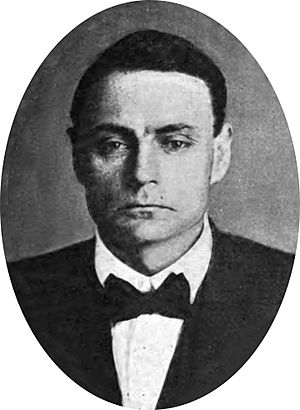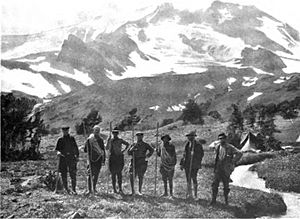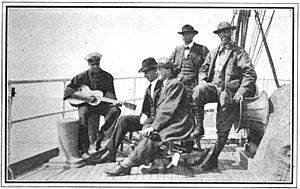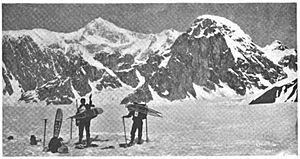Claude Ewing Rusk facts for kids
Quick facts for kids
Claude Ewing Rusk
|
|
|---|---|

Rusk, c. 1910
|
|
| Born | November 20, 1871 |
| Died | February 3, 1931 (aged 59) |
| Resting place | The Castle, Mount Adams, Washington |
| Nationality | American |
| Occupation | Teacher; Newspaper Editor; Lawyer; Receiver of the US Land Office, Yakima, WA; Author; Justice of the Peace, Grants Pass, OR |
| Known for |
|
|
Notable work
|
Tales of a Western Mountaineer |
| Spouse(s) | Rachel N. Gilmore (1898-1931) |
| Children | 1 |
Claude Ewing Rusk (born November 20, 1871 – died February 3, 1931), also known as C. E. Rusk, was an American mountaineer, lawyer, and author. He was famous for exploring and finding new climbing paths up big mountains like Mount Adams, Mount Baker, and Glacier Peak in Washington. He also climbed many other peaks in Washington, Oregon, and California.
Contents
- Claude Rusk's Life Story
- Claude Rusk's Mountaineering Adventures
- First Climbs and Explorations
- Mapping Mount Adams
- 1902 Mazamas Outing
- Mount Baker Climb
- Gathering on Mount Rainier
- Glacier Peak Ascent
- McKinley Expedition
- Exploring Mount Adams' East Side
- Mount Stuart Climbs
- Conquering the Great East Side of Adams
- Mount Hood Climb
- Mount Shasta Climbs
- Final Expeditions
- Claude Rusk's Books and Writings
- Images for kids
Claude Rusk's Life Story
Growing Up and Early Years
Claude Rusk was born in Knox County, Illinois, on November 20, 1871. When he was three years old, his family moved to Washington Territory in 1874. They settled in an area called Wood Gulch in Klickitat County.
In 1879, his family moved again, this time closer to the Columbia Hills. Claude's father built a stage station there. From the top of the Columbia Hills, young Claude loved to look at the many peaks of the Cascade Range. When he was 15, his family moved to a homestead by the Klickitat River.
Claude Rusk's Career Path
Claude Rusk went to public school. At 17, in 1888, he started his career as a teacher in the Glenwood Valley. He taught until 1892, when he became the editor of the Goldendale Courier newspaper for a year. After that, he went back to teaching.
Around the same time, he began studying law. In 1898, he married Rachel N. Gilmore. By 1902, Rusk became a lawyer and was allowed to practice law in Washington. That same year, he helped start the American Alpine Club, a group for mountain climbers.
Rusk and his wife moved a few times, living in Hamilton and then by Lake Chelan. In 1904, he joined another climbing group called the Mazamas. He practiced law in Chelan until 1910. Their only son, Rodney L. Rusk, was born in 1905 while they lived near Lake Chelan.
In 1910, Rusk led a trip to Mount McKinley in Alaska. After returning, he moved to Grants Pass, Oregon, to help his parents with their gold mine. In 1912, he moved back to Washington and became a newspaper editor again for a year. He then went back to being a lawyer.
From 1915 to 1919, Rusk worked for the United States Land Office in Yakima. During this time, he became a strong supporter of protecting nature. He admired President Theodore Roosevelt and worked to make Mount Adams a national park. He even wrote a booklet in 1919 to explain why it should be a park.
In 1920, Rusk helped create the Cascadians mountaineering club and became its first president. He made many close friends through this club. In 1922, the Cascadians gave him a special Swiss ice-axe as a gift for his leadership.
Later Life and Legacy
After his father passed away in 1923, Rusk moved back to Grants Pass and started his law practice again. In 1924, he published his most famous book, Tales of a Western Mountaineer. He also wrote another book, Timberline Campfires, but only one chapter was published later.
Rusk was appointed as a justice of the peace in Grants Pass. He was known for upholding laws strictly. On weekends, he would walk 14 miles to work at his father's gold mine.
In 1930, Rusk planned a trip to Mount Saint Elias in Alaska. No one else could join him, so he went alone. During this trip, he caught a cold that he believed weakened his heart. Claude Rusk died from heart disease on February 3, 1931, in Grants Pass.
Before he died, Rusk asked members of the Cascadians club to place his ashes on The Castle, a part of his beloved Mount Adams. On July 27, 1931, Clarence Truitt and Clarence Starcher fulfilled his wish, building a small stone monument (a cairn) that is still there today.
Claude Rusk's Mountaineering Adventures
Claude Rusk's mountaineering career lasted from 1889 to 1930, taking him all over the West Coast. People who knew him well said he was one of the most skilled and brave climbers in the West. Even though he had some risky moments, he rarely had accidents and often helped others out of danger. He was humble about his achievements and known for being determined, but also careful and thoughtful of others. Mount Adams was his favorite mountain, which he climbed many times and explored deeply.
First Climbs and Explorations
Rusk started climbing in 1889, when he and his uncle climbed Mount Adams using the South Climb path. The next year, in 1890, he, his mother Josie, and his sister Leah became the first recorded white women (and likely the first people ever) to travel all the way around Mount Adams. During this trip, he named Avalanche Valley and Rusk Glacier. The Rusk Glacier name became official in 1901 when Rusk helped map Mount Adams.
In the late 1800s, it was popular to light a big red fire on mountain tops to "illuminate" them. In 1891, Rusk tried to do this on Mount Adams but was stopped by strong winds.
In 1895, he joined the Mazamas climbing club for a special event: sending signals between the peaks of the Cascade Range using sunlight (called heliograph signaling). This included Mount Baker, Mount Rainier, Mount Adams, Mount Hood, Mount Jefferson, and Diamond Peak. Only the groups on Mount Hood and Mount Adams were able to communicate. On this trip, Rusk was happy to learn that Mount Adams was measured to be over 12,000 feet (3,658 meters) tall, as he had always believed it was one of the highest.
Two years later, in 1897, Rusk, his mother, and sister climbed Mount Adams again. His mother was so amazed by the view from a certain ridge that she insisted it be called the Ridge of Wonders.
Mapping Mount Adams
For 14 days in 1901, Rusk helped Harry Fielding Reid create a map of Mount Adams. They climbed the mountain and then circled it, with Rusk guiding the way. Rusk suggested names for several glaciers. He wanted to name the Adams Glacier after Reid, but Reid preferred it be named something else. Rusk also suggested naming the Lyman Glacier after William Denison Lyman, who had studied Mount Adams. Reid officially named Rusk Glacier after Claude Rusk.
1902 Mazamas Outing
The Mazamas club returned to Mount Adams in July 1902. Rusk joined them with a small group. Rusk's group reached the summit first. On the way down, one person became very tired, and they had to slide her down the mountain safely. Two days later, Rusk joined the main Mazamas group for their climb.
Mount Baker Climb
In 1903, Rusk and his wife tried to climb Mount Baker but bad weather stopped them. Later that year, Rusk tried again with George G. Cantwell and W. A. Alexander. Rusk and Cantwell successfully reached the top. This was the seventh time Mount Baker had been climbed and the first time directly up the Boulder Ridge.
Gathering on Mount Rainier
Rusk took part in a large "gathering of mountain clans" on Mount Rainier in 1905. He was a leader, helping a scouting party look for a safer climbing route. Over 200 climbers from different clubs, including the Sierra Club, American Alpine Club, and Mazamas, tried to climb Mount Rainier. They split into two groups, and 98 people reached the summit, with Rusk leading one of the groups.
Glacier Peak Ascent
In August 1906, Rusk climbed Glacier Peak with A. L. Cool. They were the third group to climb Glacier Peak and the first to climb its east side. The day before the climb, Rusk named Cool Glacier after Cool. The day after, he named Chocolate Glacier because of the chocolate-colored water flowing from it. With this climb, Rusk became the first person to climb all four peaks in Washington that are over 10,000 feet (3,048 meters) tall.
McKinley Expedition
In 1910, Rusk led an expedition to Mount McKinley (now known as Denali) in Alaska. This trip was supported by several newspapers and the Mazamas club. Rusk wanted to find out if Dr. Frederick Cook had really reached the summit, and to climb it themselves.
Rusk was joined by A. L. Cool, Joseph Ridley, and Frank H. Rojec. They traveled by boat and then by riverboat to reach their base camp. From there, they worked their way up the Ruth Glacier towards McKinley. It was very hard work, moving all their equipment.
Rusk soon became convinced that Cook had not climbed McKinley, but a much smaller peak. He named four peaks near a tributary glacier: Mounts Sholes, Mazama, Glisan, and Lee, after important members of the Mazamas club.
They continued up the Ruth Glacier, but their food supplies became too low to go on. Rusk wrote that it would take "weeks or months" to find a route to the summit, making Cook's claim seem impossible. They had to turn back. Another climbing team also failed to reach the summit and later found the exact rock where Cook took his famous picture, confirming Rusk's conclusion.
Exploring Mount Adams' East Side
Rusk returned to Mount Adams in 1918 to explore its east side. The next year, he spent 10 days examining possible routes with a new climber, J. Howard Green. During this trip, Rusk named the Wilson Glacier after President Woodrow Wilson, Victory Ridge to honor the end of World War I, and Roosevelt Cliff after President Theodore Roosevelt, a champion of nature.
Rusk made three attempts to climb the east side. One attempt went up Victory Ridge, but a narrow section stopped them. Another attempt went up the northern part of the Wilson Glacier, reaching about 10,000 feet (3,048 meters), but Rusk turned back due to avalanche fears. His final attempt was up Lava Ridge, where they reached about 10,500 feet (3,200 meters) but were stopped by falling rocks. Rusk felt it was too dangerous to continue with his inexperienced companion, but believed an experienced team could make the climb.
Mount Stuart Climbs
Rusk first climbed Mount Stuart in 1920. He had wanted to climb it since 1894. That same year, the Cascadians club was formed, and they decided to place a record box on the summit. Rusk successfully placed the box on the summit in July 1920.
His success inspired the club to send another group later that year, and the whole party reached the summit. Rusk climbed Mount Stuart again in 1921, earlier in the season than anyone before, proving it was possible even with snow. He led another large group up Stuart in 1922.
Conquering the Great East Side of Adams

In 1921, Rusk and a group from the Cascadians club set out to climb the "Great East Side" of Mount Adams. Their base camp was in Avalanche Valley. The main climb up the east side was led by Rusk, with Edgar E. Coursen, Wayne Richardson, Clarence Truitt, Rolland Whitmore, Robert E. Williams, and Clarence Starcher.
The route was very challenging for the climbing gear they had, which included two Swiss ice-axes, five alpenstocks (long staffs), rope, and hobnailed boots. They climbed up the Rusk Glacier to the base of Battlement Ridge, over The Castle, and through the icy cracks of the summit. The climb was so difficult that they had to spend the night on the mountain. The entire group successfully completed the climb. Other climbers who had come up from the south side were amazed and couldn't believe they had climbed from the east side.
Mount Hood Climb
Mount Hood was one of the first mountains Rusk saw when he moved to Washington, but he didn't climb it until 1922. He climbed it alone. At the top, he spent time with the fire lookout, Charles A. Phelps, who shared many stories. On the way down, Rusk had one of his few climbing accidents, slipping and sliding a short distance.
Mount Shasta Climbs
The last major Cascade Mountain Rusk wrote about climbing was Mount Shasta. In 1922, he and four members from the Cascadians tried to climb it but were stopped by ice near the top. The next year, Rusk made a solo climb and was successful. He ended his book Tales by saying that his "third of a century of mountaineering was more than rounded out," and he wouldn't complain if it was his last climb.
Final Expeditions
Even though Shasta was the last adventure Rusk wrote about, he continued to climb peaks near his home in Grants Pass, Oregon, including Mount Thielsen. However, Rusk really wanted to return to Alaska and finally conquer Mount McKinley. He tried to organize another trip for years but couldn't get funding.
Eventually, he decided to organize an expedition to Mount Saint Elias instead. Several members of the Mazamas and Cascadians initially agreed to go, but all eventually backed out. In 1930, Rusk went by himself to climb Mount St. Elias. In Yakutat, he hired a local guide. However, the boat they took accidentally dropped them off on an island. Rusk and his companion were stuck for weeks waiting for the boat to return. This was Rusk's last expedition before he passed away the following February.
Claude Rusk's Books and Writings
Claude Rusk was a talented writer. His writing was smooth and his descriptions were so vivid that readers felt like they were right there with him on his adventures. His writing style has been compared to famous English mountaineers like Edward Whymper.
Besides his book, Tales of a Western Mountaineer, he wrote several articles. "The Fourth of July on Mount Adams" and "Illuminating Mount Adams" describe his attempts to light fires on Mount Adams. "On the Trail of Dr. Cook" was a three-part article about the Mazamas McKinley expedition. "The Snow Peaks of the Cascades" described the various peaks of the Cascade Range.
His other book, Timberline Campfires, was never fully published, except for one chapter called "The Wonderful Story of Abe Lincoln," which appeared in the American Alpine Journal in 1946. His booklet Mount Adams–Towering Sentinel of the Lower Columbia Basin was written to promote the idea of making Mount Adams a national park.
Images for kids
-
Cascadians Climbing Party on the east side of Adams after the ascent. Left to Right: Richardson, Starcher, Truitt, Williams, Whitmore, Coursen, Rusk







